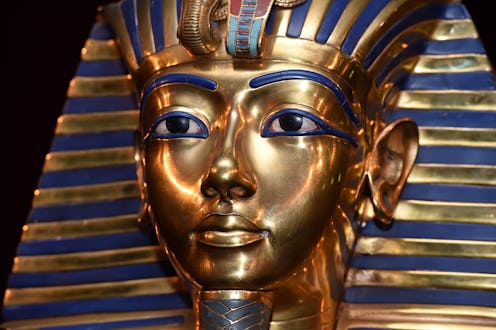Archaeologists have known the location of King Tutankhamun's burial chamber for almost 100 years, but new research suggests the Egyptian pharaoh wasn't buried alone — Queen Nefertiti may be buried in King Tut's tomb. Egyptian officials announced Thursday that Nefertiti, Tut's stepmother (or Tut's actual mother, depending on who you ask), may be in another wing of the burial chambers. Historians have wondered where Nefertiti was buried for decades. Mamduh al-Damati, Egypt's antiquities minister, said at a press conference Thursday that if the findings are confirmed, Nefertiti's burial location will be the "most important discovery of the 21st century."
Nicholas Reeves, an Egyptologist with the University of Arizona, is responsible for the proposal. While working in Cairo, Reeves posited that a series of covered lines on the burial chamber's walls may be more than decoration. Reeves, who first proposed the idea after studying scans of the tomb, believes the lines are actually hidden doors, and one of those doors could lead to a crypt where Queen Nefertiti was buried. Reeves told BBC News his theory about Nefertiti's burial in August, but it seems the rest of Egypt is finally starting to take his idea seriously. Al-Damati said on Thursday he is "70 percent certain" further investigation will reveal that Reeves is correct about Nefertiti's burial.
Al-Damati and other Egyptian officials are working to get permission to survey Tut's tomb with advanced radar technology, TIME reports. Once the radar survey is approved, the investigation could begin as early as November, and the researchers will use thermal imaging along with radar technology to determine whether there are, in fact, artificial walls in Tut's tomb. "If another wing to this tomb or one that predates it is found, that alone would be a major discovery," al-Damati said at the press conference Thursday.
"I have been testing the evidence ever since, looking for indications that what I thought I was seeing was, in fact, not there," Reeves told BBC News in August. "But the more I looked, the more information I found that I seemed to be looking at something pretty real." At a news conference in Egypt Thursday, Reeves said that the tomb's surface scans have provided him with "completely new evidence" that wasn't available to archaeologists in the past, thanks to technological developments.
Archaeologist Howard Carter first discovered King Tut's burial chambers in 1922 — the tomb was so large it took a team of archaeologists nearly nine years to catalog all of the objects it held. The reason why, exactly, Queen Nefertiti may have been buried with Tutankhamun is still unclear, though. Some scholars believe the tomb was intended to be Nefertiti's all along, but was instead used for King Tut after his sudden death at age 19. There was no tomb prepared for him at the time.
Reeves gave credence to this theory in his interview with BBC News, noting the tomb is smaller than those of other Egyptian pharaohs, suggesting it was built for a queen. "Finding Tutankhamun's tomb last century was the greatest cultural discovery in Egypt in the history of mankind," al-Damati said at the press conference Thursday. "If we find anything today, it will be the most important discovery of the 21st century."
